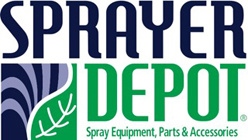Contributed by Guest Blogger: Erdal Ozkan, Professor and Extension Agricultural Engineer, Pesticide Application Technology at The Ohio State University

This is the time of the year you will get busy with spraying. Just take a moment to review some common sense ideas to get the most out of those expensive pesticides you will be spraying. Pesticides have played a key role in the abundant and high quality food we enjoy in the United States. However, this comes with a cost, and the potential health and environmental risks associated with pesticides. If you follow good application practices, you not only save money, but you also take the potential risks out of pesticides. Efficient use of pesticides must be the primary goal of an applicator to save money, and to protect the environment.
Achieving satisfactory results from pesticides depends on five major factors: a) positive identification of the pest, b) choosing the least persistent and lowest toxicity pesticide that will work, c) selecting the right equipment, particularly the right type and size of nozzle for the job, d) applying pesticides accurately at the right time, and e) calibrating and maintaining equipment.
Be well informed about the specific recommendations for a given pesticide, and follow the laws and regulations on pesticide application. Carefully read the product label to find out the specific recommendations.
Tips to Better Spraying
Here are some general recommendations that will help you achieve maximum efficacy from the pesticides.
- Always calibrate the equipment before starting to spray. It is the only way to determine whether a sprayer is actually applying a chemical at the recommended rate. For safety, calibrate with only water as the spray solution. Detailed, step–by-step information on calibration can be obtained from Ohio State University Publication AEX-520, available at: http://ohioline.osu.edu/aex-fact/0520.html
- Some chemicals and/or spray additives are highly dense and may create mixing problems if added to the sprayer tank without further diluting it. In such cases, you should mix the chemical in a small container first, and then pour into the sprayer tank to achieve a uniform mixing of active ingredients in the tank.
- Find out if the pesticide requires the use of specific adjuvants to provide good product efficacy, influence droplet size or solution evaporation rate, to reduce drift, and to improve deposit and retention on the target.
- Some pesticides are highly volatile and may require incorporation into the soil after application. Follow label recommendations to avoid drift from highly volatile pesticides.
- Carefully examine the components of the sprayer (tank, nozzles, hoses, pressure gauge, pump, etc.) to make sure they are the right type, size, and can function effectively under various operating conditions. Make sure no leakage is occurring anywhere in the spraying system. Check the tank agitation system to make sure the flow to the tank for agitation is sufficient and effective.
- Application equipment generally arrive already set up with a particular nozzle spacing that is typical for the type of spraying to be performed (i.e. row crop sprayer, floater, etc.). Choose the appropriate equipment setup best suited for a given situation (banding, broadcast, directed spraying, etc.).
- Spray pressure affects the performance of a sprayer in several ways. It changes the application rate as well as the size of droplets. Make sure you have an accurate and functioning pressure gauge on the sprayer, and operate the sprayer within the pressure range recommended by the nozzle manufacturer.
- Boom height affects the spray pattern overlap, deposition uniformity on the target, and the time during which the droplets are exposed to wind and evaporation, both of which directly influence drift. Keep the boom height to a minimum to reduce drift.
- Maintain uniform deposition of spray material on the target across the boom. Uniformity of deposition is as important as the amount deposited. Non-uniform coverage can result from simple reasons such as using misaligned or clogged nozzles, nozzles with different fan angles, or from uneven nozzle height across the boom. These common problems result in streaks, untreated areas, or over-application of chemicals.
- Observe the output pattern of nozzles periodically. Streaks in the pattern indicate that foreign materials are inside the nozzles. Remove such particles from the nozzle tip using a wooden tooth pick or soft object; clean the nozzle filter using a soft brush. Maintain the sprayer in peak condition by periodic inspections and repairs. Carry extra nozzles, washers, other spare parts, and tools for quick repairs in the field.
- Spray drift is one of the most serious problems the pesticide applicators have to deal with. It wastes expensive pesticides, may damage non-target crops nearby, and may pose a health risk to people living in areas where drift is occurring. Spray drift accounts for about half of all non-compliance cases investigated by the Ohio Department of Agriculture. So, take spray drift seriously. Various drift reduction strategies are outlined in OSUE Bulletin 816.
Chemical manufacturers recommend the proper label. However, how close you can get to their recommendation is your responsibility. You will be hurt economically whether you apply more than the recommended rate or less. Too little pesticide results in poor pest control and reduced yields, while too much injures the crop, wastes your chemical dollars, and increases the risk of polluting the environment. Hopefully some of the points I raised in this article will help you achieve maximum efficacy from pesticides you apply.
Erdal Ozkan, Professor and Extension ag engineer, can be reached at 614-292-3006, or ozkan.2@osu.edu. This column is provided by the OSU Department of Food, Agricultural and Biological Engineering, OSU Extension, Ohio Agricultural Research & Development Center, and the College of Food, Agricultural and Environmental Sciences.

.png?width=280&name=SameDayShippingGuarantee-New%20(1).png)



